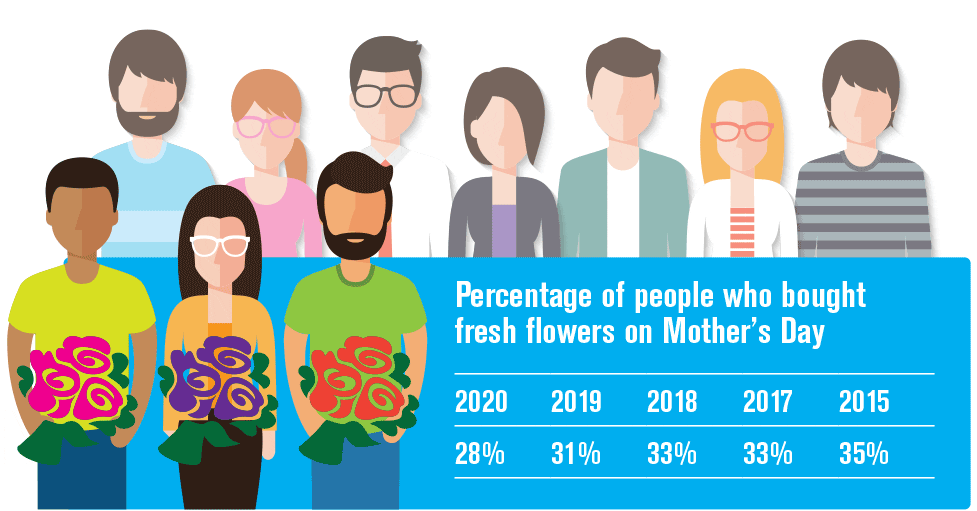Despite a global pandemic, an Ipsos poll conducted this month on behalf of the Society of American Florists found only a slight decrease in the number of American adults buying Mother’s Day flowers and plants this year – and a slight increase in their median and average spending per gift.
This year’s poll found that about three in 10 (28 percent) American adults bought fresh flowers or plants as gifts for Mother’s Day. Most of the floral gifts purchased were fresh bouquets (58 percent) and fresh arrangements (57 percent). By comparison, roughly a third of American adults purchased fresh flowers or plants as gifts in 2019 (31 percent), 2018 (33 percent), 2017 (35 percent) and 2015 (35 percent).
Meanwhile, the median amount spent on flowers as gifts for Mother’s Day in 2020 was $45, an increase from 2019 and 2018 (both $35). The average amount spent in 2020 is slightly above the average amount spent in 2019 ($54 vs. $52.10).
“We’re really encouraged to see that spending increased, despite the many potential obstacles – financial, logistical – that could have driven floral spending on gifts downward,” said SAF CEO Kate Penn. “Anecdotally, we’ve been hearing that average order values were up, and the SAF member survey confirms this, but it’s good to see it also confirmed in this consumer research.”
Make plans to join industry leaders on Thursday, May 28, at 2 p.m. EDT for an SAF webinar focused on taking a deeper dive on these holiday results, including best practices, advice on interpreting the data and practical tips on how you can use these insights to plan for future success.
Other highlights of this year’s poll include:
Customer Demographics: Gen X and Y, Higher Income Households
Similar to last year’s results, adults ages 54 and below were more likely to buy flowers for Mother’s Day, with adults ages 18-34 the most likely to have purchased flowers (44 percent vs. 26 percent of adults age 35-54 and 17 percent of adults ages 55 and over).
Existing customers proved to be reliable leads: 60 percent of those who said they purchased flowers last year, purchased again this year. Higher income (those making $50,000 a year or more) households were more likely to have bought fresh flowers for Mother’s Day than those with a household income under $50,000 (31 percent vs. 24 percent). Unsurprisingly, households with children were more likely to have bought flowers for Mother’s Day than those without children (42 percent and 24 percent respectively).
Product Preference: Cut Flowers Rule
While most the flowers or plants purchased as a gift for Mother’s Day were fresh floral bouquets and fresh floral arrangements, other popular floral gifts include outdoor bedding, garden, or container plants (43 percent) and flowering houseplants (40 percent).
The types of flowers purchased in 2020 follow a similar trend to that in 2019 and earlier years. In general, fresh flowers continue to be the most popular type of flower purchase. Fresh floral bouquets were the most popular gift for Mother’s Day from men (63 percent), while fresh floral arrangements were the most popular gift from women (53 percent).
Venue Selection: Wholesale Clubs Gain Market Share
While supermarkets and grocery stores continue to be the leading outlet for purchasing Mother’s Day flowers, market share shifted some for Mother’s Day 2020. A third of adults (33 percent) who purchased floral gifts patronized these venues this year. That percentage represents a drop from both 2019 (39 percent) and 2018 (48 percent).
About 16 percent purchased from local retail florist shops, which is roughly on par with 2019 (15 percent) and down from 2018 (21 percent).
On the other hand, mass merchandisers and wholesaler clubs saw continued gains, with nearly a quarter of adults purchasing flowers from these outlets (24 percent). In previous years, mass merchandisers and wholesale clubs were less popular, with 19 percent buying from there in 2019, 13 percent in 2018, and 17 percent in 2017.
Roughly two in 10 purchased from an Internet floral service (22 percent) or home improvement center (19 percent). Independent garden centers, greenhouses, and nurseries were a less popular retail source for flower purchasing in 2020 (17 percent), compared to 2019 (23 percent) and 2018 (20 percent).
The three leading outlets among respondents who spent less than $70 on Mother’s Day flowers this year was supermarkets or grocery stores (36 percent); mass merchandiser/wholesale club (25 percent) and home improvement center (19 percent). Respondents who spent more than $70 most frequently purchased from Internet floral services (43 percent); mass merchandisers and wholesaler club (24 percent) and local retail flower shops (24 percent) .
Gift Trends by Recipients
Flower purchasers this year were most likely to report purchasing the flowers for their mothers — a result that tracks with returns from previous years. Nearly seven in 10 Americans who purchased flowers for Mother’s Day in 2020 said they purchased flowers for a mother (69 percent), followed by wife/spouse (20 percent), mother-in-law (18 percent), and grandmother (10 percent).
The SAF-Ipsos poll was conducted between May 11-12, 2020. A sample group of roughly 1,002 adults age 18 and older from the continental U.S., Alaska, and Hawaii was interviewed online in English.
Mary Westbrook is the editor in chief of Floral Management magazine.


